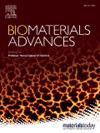定制高通量微流体生产用于骨修复的多功能多孔微球
IF 6
2区 医学
Q2 MATERIALS SCIENCE, BIOMATERIALS
Materials Science & Engineering C-Materials for Biological Applications
Pub Date : 2025-07-21
DOI:10.1016/j.bioadv.2025.214426
引用次数: 0
摘要
骨修复材料的开发已成为解决骨缺损的一个关键问题。现有的方法,如自体移植和同种异体移植,受到免疫排斥和局部抗感染不足等问题的限制。尽管生物相容性支架在药物和细胞递送方面有很大的前景,但在制造均匀、稳定和可注射的多功能支架以实现有效的骨修复方面仍然存在挑战。在这里,我们提出了一个定制的同轴微流体系统,设计用于高通量制造PDTH多孔微球(PDTH pm)。该系统确保了对微球大小和结构的精确控制,生产出均匀、稳定的微球,微球孔相互连接,显著提高了药物包封效率。PDTH pmms由PLGA组成,由PDA和含有TOB和HA纳米颗粒的水凝胶功能化,具有显著的生物相容性,清除ROS和抗菌性能。在体外,这些微球能有效促进骨髓间充质干细胞的增殖、迁移和成骨分化。在体内,使用大鼠颅骨骨缺损模型,PDTH pmms显着改善骨再生,增加骨矿物质密度和新骨形成。通过组织检查和血液分析进行的生物安全性体内评估证实对主要器官无不良影响。我们的工作介绍了一种多用途的骨缺损修复方法,强调了微流体制备的多功能微球在骨再生策略中的潜力。本文章由计算机程序翻译,如有差异,请以英文原文为准。
Customized high-throughput microfluidic production of multifunctional porous microspheres for bone repair
The development of bone repair materials has become a critical focus in addressing bone defects. Existing methods, such as autografts and allografts, are limited by issues like immune rejection and insufficient local anti-infection. Despite the promise of biocompatible scaffolds in drug and cell delivery, challenges persist in creating uniform, stable and injectable scaffolds with multifunctional properties for effective bone repair. Here, we present a customized coaxial microfluidic system designed for the high-throughput fabrication of PDTH porous microspheres (PDTH PMs). This system ensures precise control over microsphere size and structure, producing uniform, stable microspheres with interconnected pores that significantly enhance drug encapsulation efficiency. The PDTH PMs, composed of PLGA and functionalized with PDA and a hydrogel containing TOB and HA nanoparticles, demonstrate remarkable biocompatibility, ROS scavenging, and antibacterial properties. In vitro, these microspheres effectively promote BMSC proliferation, migration, and osteogenic differentiation. In vivo, using a rat calvarial bone defect model, PDTH PMs show significant improvement in bone regeneration, with increased bone mineral density and new bone formation. Biosafety in vivo assessments via histological examination and blood analysis confirm no adverse effects on major organs. Our work introduces a versatile method for bone defect repair, highlighting the potential of microfluidic-prepared multifunctional microspheres in bone regeneration strategies.
求助全文
通过发布文献求助,成功后即可免费获取论文全文。
去求助
来源期刊
CiteScore
17.80
自引率
0.00%
发文量
501
审稿时长
27 days
期刊介绍:
Biomaterials Advances, previously known as Materials Science and Engineering: C-Materials for Biological Applications (P-ISSN: 0928-4931, E-ISSN: 1873-0191). Includes topics at the interface of the biomedical sciences and materials engineering. These topics include:
• Bioinspired and biomimetic materials for medical applications
• Materials of biological origin for medical applications
• Materials for "active" medical applications
• Self-assembling and self-healing materials for medical applications
• "Smart" (i.e., stimulus-response) materials for medical applications
• Ceramic, metallic, polymeric, and composite materials for medical applications
• Materials for in vivo sensing
• Materials for in vivo imaging
• Materials for delivery of pharmacologic agents and vaccines
• Novel approaches for characterizing and modeling materials for medical applications
Manuscripts on biological topics without a materials science component, or manuscripts on materials science without biological applications, will not be considered for publication in Materials Science and Engineering C. New submissions are first assessed for language, scope and originality (plagiarism check) and can be desk rejected before review if they need English language improvements, are out of scope or present excessive duplication with published sources.
Biomaterials Advances sits within Elsevier''s biomaterials science portfolio alongside Biomaterials, Materials Today Bio and Biomaterials and Biosystems. As part of the broader Materials Today family, Biomaterials Advances offers authors rigorous peer review, rapid decisions, and high visibility. We look forward to receiving your submissions!

 求助内容:
求助内容: 应助结果提醒方式:
应助结果提醒方式:


